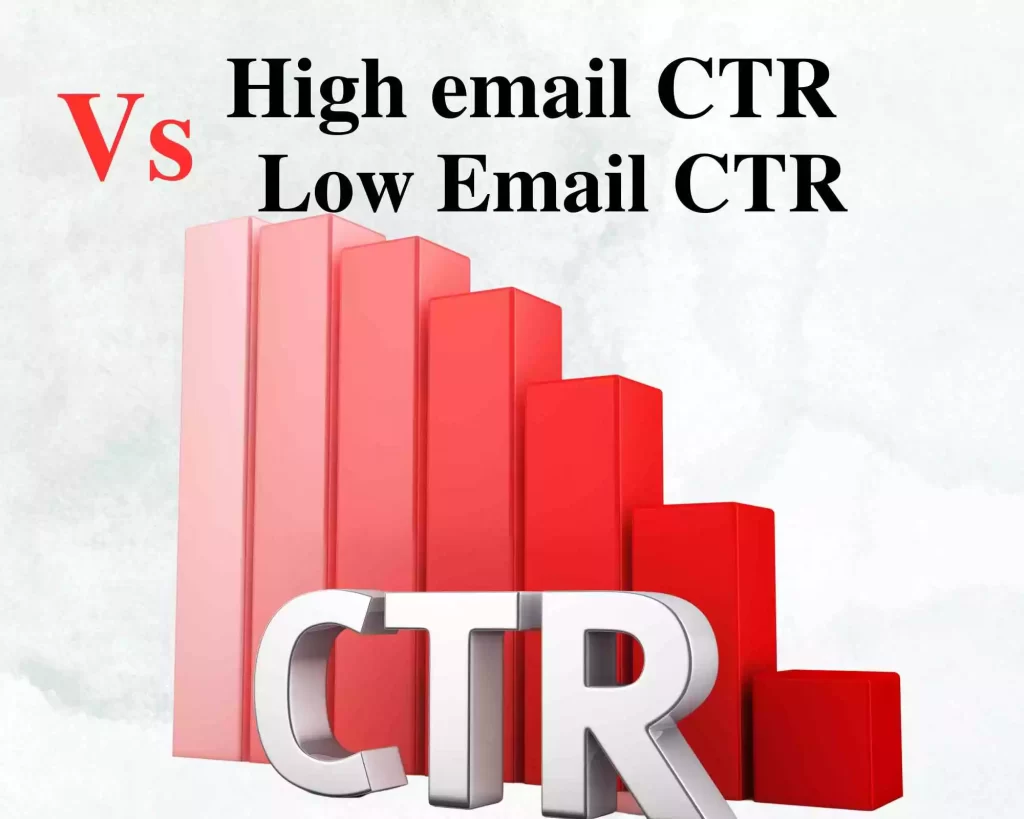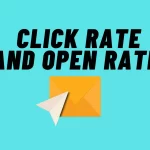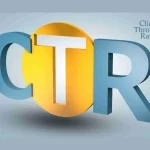Are you ready to know what is high email CTR vs low CTR email?
The difference between a high and low email click-through rate (CTR) is the proportion of subscribers that click on a link inside your email.
As someone who has spent significant time and effort working in digital marketing, I know the importance of a solid email marketing approach.
The email click-through rate (CTR) is an important metric for email marketers to monitor.
In this post, I’ll explain what high email CTR vs low email CTR means and all you need to know about it.
Please read our guide on how to write an email that stands out.
Let’s dive deeper and discover more about what high and low email CTR means.
What Is Considered A High CTR Email?
What is considered a high email CTR varies based on the industry and the particular context of your email campaign.
Moreover, a high CTR means that recipients find the information in your emails relevant and are willing to click through to know more.
Generally, a CTR of 20% or greater is regarded to be a high email CTR. In comparison, a CTR of less than 3% is regarded to be poor.
It’s crucial to note that what’s considered a “high” CTR might also depend on the sort of email you’re sending. For example, a promotional email advertising or a limited-time discount has a greater CTR than a newsletter containing regular business information.
Also, having a high email CTR doesn’t always mean that your email campaign was successful.
That doesn’t always ensure they did the required activity or turned into clients. So, it’s necessary to measure additional metrics like conversion rate and income earned to establish the entire performance of your email campaign.
Now, let’s check up on what a low CTR is.
What Is Considered A Low Email CTR?
As I previously said, in what is considered a high email CTR. What also constitutes a “low” email click-through rate (CTR) varies according to the industry and context of your email campaign.
A CTR of less than 2% is often regarded as a low email CTR. (Source)
A low CTR might suggest your email content isn’t connecting with your target audience. It might also indicate that your email list needs to be adjusted or that your email frequency is too high or too low.
In some circumstances, a low CTR might be due to a technical problem, such as broken links or a bad email layout.
If your CTR is regularly low, you should analyze your email content and try testing alternative tactics to find what works best for your audience.
Please read our guide on how to write an email that stands out
It’s also a good idea to look through your email list and make sure you’re targeting the right people (segmentation).
Consider trying various factors, including subject lines, sending frequency, and email design, to increase the overall efficacy of your email campaign.
How To Measure Email CTR
Email click-through rates (CTR) are an important component you need to understand when it comes to email marketing.
Here are 3 simple steps to calculate your email CTR:
- Consider how many individuals have clicked on a link in your email.
- Divide that amount by the number of emails sent
- and multiply it by 100 to obtain a percentage.
What You Need To Be Aware Of When Measuring Your Email Ctr
1. Identify your email’s purpose:
When launching an email campaign, you must first define the primary purpose or goal of your email.
Do you want your audience to click a link, sign up for an event, or buy something? Understanding the purpose of your email can help you decide which links to monitor and which metrics to pay attention to.
2. UTM codes may be used to track clicks:
UTM codes are tags that may be applied to email links to monitor where your traffic is coming from. You can measure how many hits you’re getting and which links are creating the greatest interaction by adding unique UTM codes to each link in your email.
3. Employ the services of an email service provider (ESP):
Most email service providers provide monitoring and reporting tools that enable you to monitor your email stats.
These tools allow you to measure email opens, clicks, and other engagement metrics in real time, enabling you to make data-driven choices to improve your campaigns more swiftly.
4. Evaluate your email stats:
When you send out your email campaign, it’s time to look at your data. To measure the overall performance of your campaign, examine your email CTR, open rate, conversion rate, and other engagement data. Make data-driven choices to optimize your future email marketing using this data to discover areas for improvement.
You may acquire useful insights about the efficiency of your email campaigns and enhance your email marketing strategy over time by monitoring and evaluating your email CTRs regularly.
What Is The Difference Between High And Low Email CTR?
As I have said earlier. The difference between a high and low email click-through rate (CTR) is the percentage of subscribers who clicked on a link within your email.
But to explain better.
A high CTR implies that a large proportion of your email recipients clicked on the link in your email, while a low CTR shows that a lower proportion of recipients clicked.
A high CTR is often seen as a sign that the email content is interesting and relevant to your target. Your email recipients found it intriguing enough to visit your website or landing page.
A high CTR also indicates that your email list is properly classified and that you are targeting the correct recipients with relevant communications.
A low CTR, on the other hand, can mean that your audience isn’t responding to the email content you’re sending, that your email list needs to be improved, or that your email frequency is either too high or too low.
The presence of technical problems, such as broken links or improper email layouts, might also be a reason for a low CTR.
The difference between a high and low CTR shows how successfully your email campaign is connecting with your audience.
You can spot areas for improvement and make data-driven changes to enhance your email campaigns for higher engagement and conversion rates.
Why Is High Email CTR Good?
A high email click-through rate (CTR) is generally considered a good thing because it indicates that a significant portion of your email recipients found your email content interesting and engaging enough to click through to your website or landing page.
A high CTR is beneficial for your email marketing efforts for the following reasons:
What Are The Benefits Of High CTR Email?
1. Increased engagement
A high CTR shows that your email subscribers are actively interacting with your emails, which may foster longer-term brand loyalty and better levels of engagement.
2. Higher conversion rates:
With a high email CTR. You have a better chance of turning readers into buyers or subscribers when more people click through to your website or landing page.
3. A better reputation for emails:
Email providers like Google and Yahoo use email engagement rates when determining whether to send emails to the inbox or the spam bin.
High CTR indicates to email providers that your emails are interesting and relevant to your audience, which may boost email reputation and delivery.
4. Higher return on investment (ROI):
When your emails have a high CTR, you’re receiving more out of your email marketing efforts, which translates into a greater ROI for your company.
In general, a high CTR is a sign that your email marketing approach is working and that your audience is responding favourably to the content of your emails.
Is A Low Email CTR Good?
The answer to the question if a low CTR is good is NO. A low email click-through rate (CTR) is generally not regarded as favorable for your email marketing initiatives.
A low CTR might suggest that your email content isn’t connecting with your audience, that your email list needs to be refined, or that your email frequency is too high or too low. These are some of the reasons why a low CTR is bad for your email campaigns:
Reasons Why A Low CTR Is Bad For Your Email Campaigns
1. Low participation:
A low CTR indicates that a lesser number of your email readers are actively interacting with your material, which may lead to diminished brand engagement and loyalty over time.
2. Reduced conversion rates:
When fewer individuals visit your website or landing page, you have lower chances of converting those visitors into buyers or subscribers.
3. Bad email reputation:
Email providers such as Google and Yahoo use email engagement rates when selecting whether to send emails to the inbox or the spam bin.
If your emails have a regularly low CTR. Email providers may conclude that they are neither interesting nor relevant to your audience, resulting in worse email deliverability and reputation.
4. Reduced ROI:
When your emails have a low CTR, you’re obtaining less value from your email marketing efforts, which results in a poorer return on investment (ROI) for your company.
Although a low CTR is not good for email campaigns, it can present a chance to learn and improve your email marketing approach.
You can enhance your email engagement rates and produce greater outcomes. By evaluating your email stats, tweaking your email content, and making data-driven changes.
Is It Better To Have A Higher Or Lower Email CTR?
It is totally better to have a high email CTR. Since a high email CTR shows that a larger proportion of your email subscribers found your content interesting and relevant enough to go on to your website or landing page.
A higher CTR will result in increased engagement, a better reputation for emails, higher conversion rates, and a better return on investment (ROI) for your email marketing initiatives.
Tips For High And Low Email CTR
Suppose you have a low email CTR. It is better to optimize your email campaigns for higher engagement and conversion rates. The tip is to routinely check your email analytics, evaluate the data, and make data-driven choices.
Your email content, email list segmentation, or email frequency may all need to be adjusted if your CTR is persistently low. In order to better connect with your audience.
But, if your CTR is regularly high. You may want to keep experimenting with your email content and strategies to see if you can boost your performance.
Conclusion
In conclusion. Knowing the difference between high email click-through rates (CTR) and low email CTR is vital for every effective email marketing strategy.
A high CTR implies that your email content is engaging and connecting with your audience, leading to greater levels of engagement, improved conversion rates. And a better return on investment (ROI) for your organization.
On the other side. A low CTR might signify that your email content needs refining. Your email list needs segmenting, or your email frequency needs altering to better connect with your audience.
By monitoring your email analytics frequently, evaluating the data, and making data-driven choices. You can improve your email campaigns for greater engagement and conversion rates.
Note that a high CTR is not just a sign of success. But also a source of useful information about your audience’s tastes and behavior. Which can help you tweak your email marketing plan for even greater outcomes





